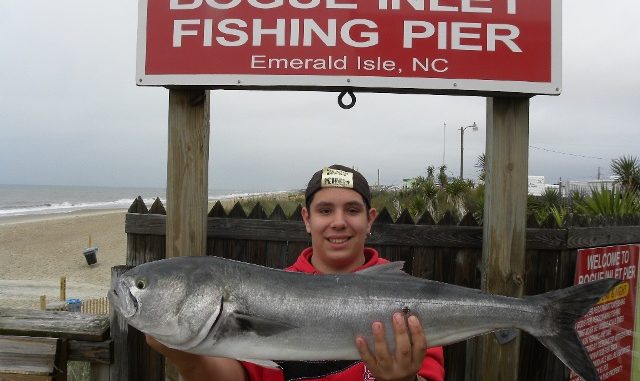
Three years ago Hatteras (chopper) bluefish once again began appearing at North Carolina central coast venues.
Thirty years ago these large toothy creatures made dependable October and November appearances at the Cape Hatteras National Seashore, most prominently at Ocracoke Island. Anglers would catch them by the truckloads, wastefully stacking them like cordwood on the Ocracoke beaches (they’re not very tasty but fight like a shark). And they’d hit any kind of lure from Hopkins to, famously, a strip of flannel shirt impaled on a J-hook.
Those blues were so ravenous they’d chase schools of big gray trout onto the sand, and anglers happily collected the tasty trout to take home for the frying pan or grill.
Then the blues disappeared for decades, with their famous “runs” only a faded, exciting memory — until 2009.
“We’re in a chopper bluefish run right now,” said Matt Lamb of Chasin’ Tails Outdoors Shop at Atlantic Beach (252-240-3474, www.chasintailsoutdoors.com). “You can catch them two ways.
“The best way is in a boat so you can chase the schools and throw lures to them. But they’re cruising close to the beaches and you can sight fish for them.”
Today anglers throw modern lures at big blues, casting topwater lures such as TopDogs, normally a red drum inshore lure.
“I’ve seen guys fishing for blues from the beaches around here,” Lamb said. “There’s been a lot caught in the Fort Macon area.”
A popular bluefish lure at beaches and piers is a live finger-mullet rig — a float, wire and a two-prong treble hook in a mullet.
“Guys are running a metal wire through a finger mullet’s mouth, out through its tail, then they wire on a two-prong treble,” he said. “(The blues) are cruising on top (the surface), and when they see that mullet, they can’t stand it.”
The wire is used instead of monofilament leaders because a bluefish’s razor-sharp teeth easily will slice through nylon or fluorocarbon leaders.
“They’ll get your fingers, too, so you have to be careful,” Lamb said.
With savage dispositions, chopper blues have been known to mangle hands. Rumors exist of blues nipping off parts of fingers by careless anglers who place their digits near a blue’s mouth.
“The blues weigh from 6 to 10 1/2 pounds,” Lamb said. “I’ve heard a rumor of a 20-pounder caught April 28, but I didn’t see it and I haven’t seen a photo.”
North Carolina “tailor” blues normally weigh 1 to 2 pounds.
One of the top places for big bluefish runs has been Bogue Inlet Pier, where anglers have caught chopper blues the previous two years.
“I know it’s a temptation to keep them, but anglers need to take a picture, then release big blues,” Lamb said. “They’re not very good to eat; smaller ones taste much better. And we need to not wipe them out. They’re too much fun to catch and release. Just be sure to use a pair of pliers to remove the hooks.”


Im not sure why you say bigger blues are not worth eating but that is own preference. So where is the hotest spot thats in walking distance to surf fish or to fish off a pier for bluefish.
Sorry i meant where in hatteras. Also are they catching big ones at oregon inlet bridge